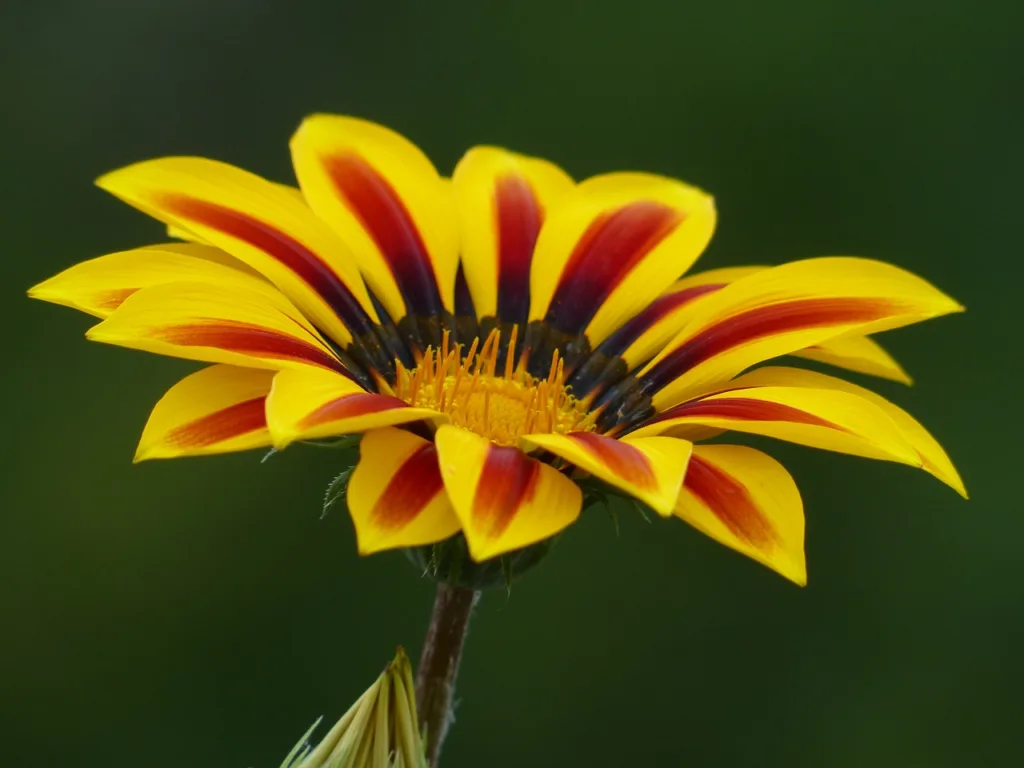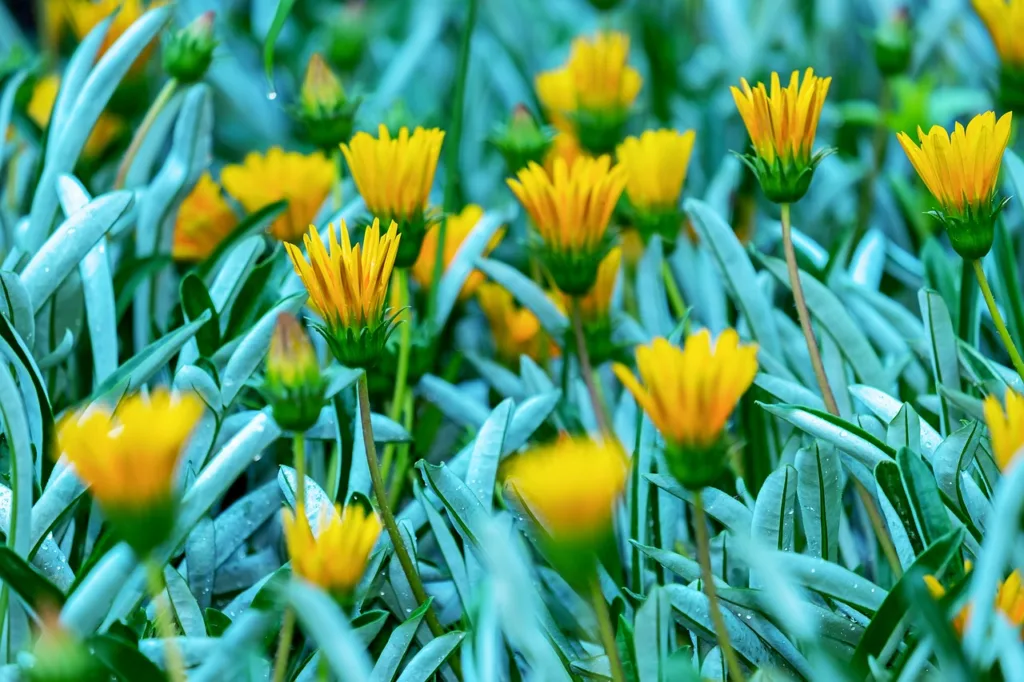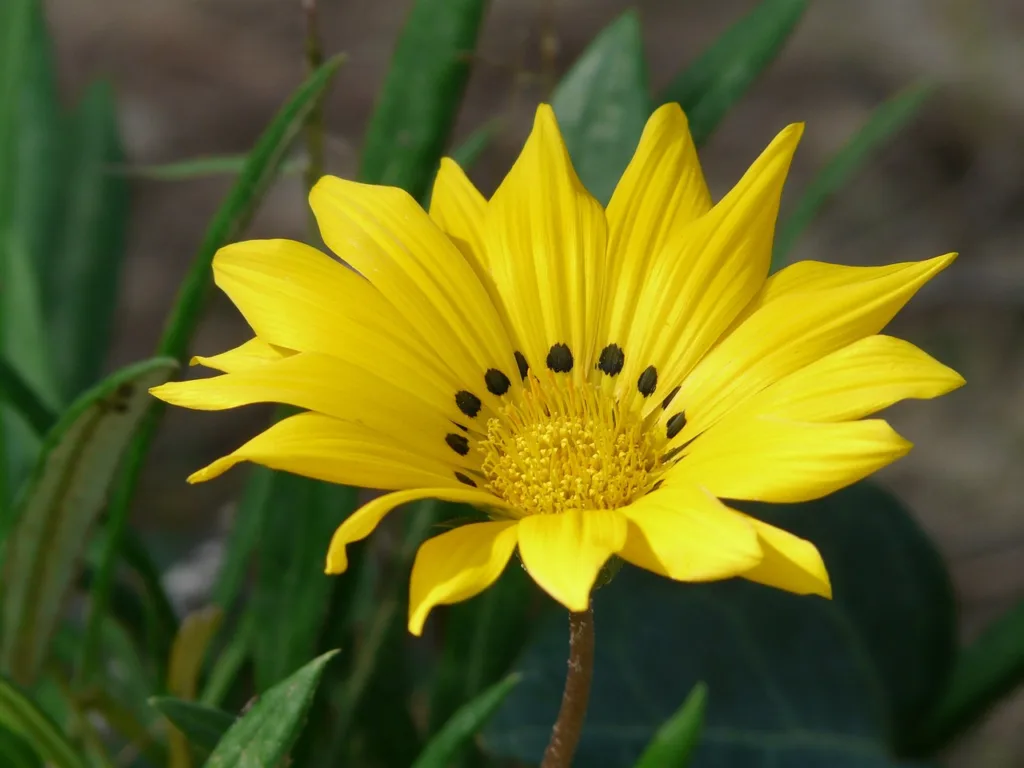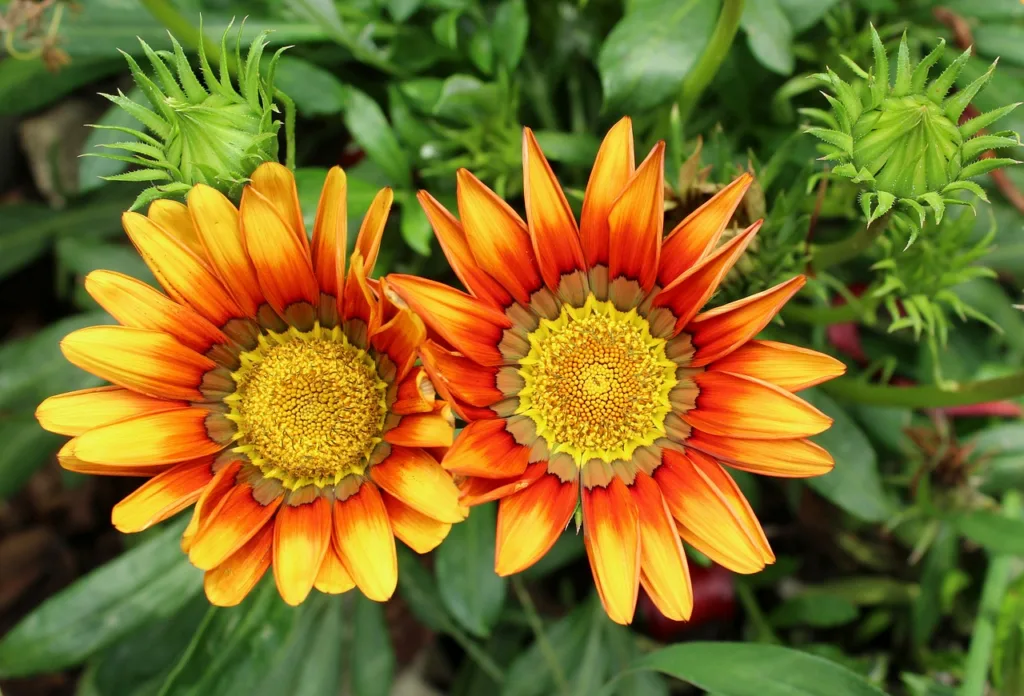Gazania rigens is a specific species within the Gazania genus, commonly known as Treasure Flower or African Daisy. In other words, Gazania rigens is a type or variety of Gazania
Because of its daisy flowers and low-maintenance nature, it’s no wonder that many gardeners are drawn to growing and caring for this beautiful plant.
Gazania plants are native to South Africa and thrive in warm and sunny climates. They are known for their tolerance to drought and ability to withstand hot temperatures, making them suitable for gardens in dry areas.
If you live in an area with a cold and humid climate, you can still grow gazania as an annual plant or in containers that can be moved indoors during adverse weather conditions.
“Fleur Gazania” translates to “Gazania flower” in English
| Aspect | Description |
|---|---|
| Scientific Name | Gazania spp. |
| Common Names | Treasure Flower, African Daisy |
| Plant Type | Perennial or annual |
| Height | Typically 8 to 18 inches (20 to 45 cm) |
| Foliage | Green, lance-shaped leaves |
| Flower Type | Daisy-like, single or double blooms |
| Flower Colors | Vibrant shades of yellow, orange, red, and pink |
| Blooming Season | Spring to fall, depending on the variety |
| Sun Exposure | Full sun |
| Soil Type | Well-draining soil |
| Watering Needs | Drought-tolerant; water sparingly once established |
| Maintenance | Low maintenance, deadheading promotes continuous blooming |
| Special Features | Heat-tolerant, suitable for rock gardens, containers |
| Hardiness Zones | Typically zones 9-11; varies by species |
Types of Gazania Rigens
Gazania flower, commonly known as Treasure Flower or African Daisy, has several varieties and cultivars with variations in flower color, size, and growth habits. Here are some popular types of Gazania rigens:
- Gazania rigens ‘Daybreak Series’:
- Features large, daisy-like flowers in vibrant colors such as yellow, orange, and pink.
- Compact growth habit, making it suitable for borders and containers.
- Gazania rigens ‘New Day Series’:
- Known for its large, single flowers in a range of colors, including bright yellows and oranges.
- Compact and well-branched, creating a dense and colorful display.
- Gazania rigens ‘Talent Series’:
- Characterized by its robust growth and a mix of bold colors like red, yellow, and orange.
- Suitable for both landscape and container gardening.
- Gazania rigens ‘Colorado Gold’:
- Notable for its golden-yellow flowers with dark centers.
- Drought-tolerant and well-suited for xeriscaping.
- Gazania rigens ‘Big Kiss Series’:
- Features large, double flowers in various colors, including shades of pink, orange, and yellow.
- Compact and bushy growth habit.
- Gazania rigens ‘Sunglow’:
- Exhibits bright yellow flowers with a dark center.
- Well-adapted to sunny and dry conditions.
- Gazania rigens ‘Frosty Kiss Series’:
- Characterized by its unique bicolor flowers with frosty or silvery edges.
- Adds an interesting visual element to garden displays.

Choosing the Right Variety
Before going into details of gazania cultivation and care, it is important to choose the right variety for your garden.
Gazania flower plants come in a variety of colors, including yellow, orange, red, and pink. Some varieties also have unique color patterns such as stripes and multicolored flowers.
Consider your garden’s color scheme and personal preferences when selecting a variety that matches your overall landscape design.
Soil Preparation
Gazanias prefer well-drained soil that is neutral to slightly acidic in pH. Before planting, prepare the soil by loosening it with a garden fork or tiller.
Remove any weeds or debris and mix in some organic matter, such as compost or well-rotted manure, to improve soil fertility and drainage.
This step is important because it ensures that your gazania has the right conditions to establish a strong and healthy root system.
Propagation Methods
Gazanias can be propagated through seeds, cuttings, or divisions. Here are some methods you can try:
Seed: The most common method of propagation is by sowing seeds directly into the garden or in seed trays. Gazania is easy to grow in pots, it makes the yard shine.
Sow the seeds in early spring or after the last frost, following the instructions on the seed packet. Keep the soil moist until germination occurs, which typically takes two to three weeks.
Cutting: Take semi-hardwood cuttings from the tips of healthy gazania plants in late spring or early summer. Remove the leaves from the lower half of the cuttings and dip them in rooting hormone.
Place the cutting in a pot filled with well-drained potting mix and place it in a warm and bright location. Water the cutting regularly and within a few weeks it should develop roots.
Division: If you already have mature gazania plants, you can divide them to form new plants. Dig up the plant in early spring or fall and carefully separate the clumps into small sections, making sure each section keeps a portion of the root system intact. Replant the divisions in prepared soil and water them well.
Growing Gazania
Now that you have everything ready, it’s time to learn how to grow gazania successfully. Follow these guidelines to ensure your gazanias thrive in your garden.
Planting and Spacing
Plant your gazanias flower in well-drained soil and choose a location that receives full sun exposure. Dig a hole slightly larger than the root ball of the plant and place it in the hole, making sure the crown is level with the soil surface. Space your gazanias 8 to 12 inches apart to allow for proper air circulation and growth.
Watering and Fertilizing
While gazanias are drought-tolerant, they still require regular watering, especially during dry spells or prolonged periods without rainfall.
Water the plants deeply, ensuring the water reaches the root zone. Avoid overhead watering as it can promote the development of fungal diseases.
During the growing season, fertilize your gazanias every four to six weeks with a balanced, water-soluble fertilizer.
Follow the instructions on the fertilizer package to determine the appropriate amount to use. Over-fertilizing can lead to excessive foliage growth and fewer blooms, so it’s important to strike a balance.

Pruning and Deadheading
To encourage continuous blooming and maintain a compact shape, deadhead spent flowers regularly. This involves removing the faded blooms by pinching them off at the base.
Deadheading prevents the plant from producing seeds and redirects its energy towards producing new flowers. Additionally, pruning can be done in early spring to remove any dead or damaged foliage and stimulate new growth.
Mulching and Weed Control
Applying a layer of organic mulch around your gazania plants can help conserve soil moisture, suppress weed growth, and regulate soil temperature.
Mulch also adds a decorative touch to your garden bed. Use a thin layer, around 2 to 3 inches, and avoid piling it directly against the stems of the plants to prevent rot and fungal diseases.
Regularly inspect your gazania plants for weed growth and remove any intruders promptly. Weeds compete with gazanias for nutrients and water, and their presence can hinder the overall health and growth of your plants.
Common Pests and Diseases
While gazanias are relatively resilient plants, they are not completely immune to certain pests and diseases. Here are some of the common issues you may encounter and how to address them:
Aphids: These small, sap-sucking insects can be controlled by spraying affected plants with a strong stream of water or applying insecticidal soap. Ladybugs and lacewings are natural predators of aphids and can help keep their populations in control.
Powdery Mildew: Powdery mildew appears as a coating of white powder on the leaves, stems, and flowers of gazania.
Ensuring good air circulation, avoiding overhead watering, and applying a fungicide labeled for powdery mildew can help control and prevent this fungal disease.
Root rot: Overwatering or poorly drained soil can lead to root rot, which causes the plant’s roots to rot. To prevent root rot, make sure your gazania is planted in well-draining soil and avoid overwatering.
If root rot has already occurred, it may be difficult to save the plant, but you can try to save it by cutting off the affected roots and repotting them in fresh, sterile soil.
Gazania Flower Season in India
The Gazania flower is known for its ability to bloom in response to sunlight, typically opening its petals in the morning and closing them in the evening.
In India, where the climate varies across different regions, Gazania flowers are often cultivated as annuals or perennials, depending on the specific species and local conditions.
Generally, Gazania flowers can be expected to bloom during the warmer months, which in most parts of India would be from spring (March to May) through early autumn (September to November).
However, the exact blooming season can vary based on factors such as temperature, sunlight, and local climate conditions.
To get the most accurate information for your specific location in India, it’s advisable to check with local nurseries or gardening experts who are familiar with the specific growing conditions in your region.

Conclusion
Growing and caring for gazania is a rewarding experience that can add vibrancy and beauty to your garden.
By following the guidelines outlined in this comprehensive guide, you can ensure that your gazanias thrive and continue to provide you with stunning blooms throughout the growing season.
Remember to choose the right variety, prepare the soil adequately, and provide the necessary care in terms of watering, fertilizing, and pruning. With a little effort and attention, you can enjoy the splendor of gazania in your garden for years to come.
People Also Ask
- Do Gazanias need full sun?
- Yes, Gazanias thrive in full sun. They prefer well-lit and sunny locations, and their vibrant flowers open fully under direct sunlight. Adequate sunlight is essential for the healthy growth and blooming of Gazanias.
- Is Gazania a seasonal flower?
- Gazania rigens are often grown as an annual or short-lived perennial, depending on the climate. In colder regions, it is treated as an annual, while in warmer climates, it may behave as a perennial, coming back in subsequent growing seasons.
- Which month to sow Gazania seeds in India?
- Gazania seeds can be sown in India during the spring months, which typically span from March to May. Spring provides the warm and sunny conditions that Gazanias favor for germination and early growth.
- What is a Gazania used for?
- Gazanias are commonly used for ornamental purposes in gardens and landscapes. Their colorful and daisy-like flowers make them popular choices for adding visual appeal to flower beds, borders, rock gardens, and containers. They are also suitable for ground cover and are appreciated for their resilience in hot and dry conditions.
- Do Gazanias come back every year?
- Gazanias are typically grown as annuals or short-lived perennials. In warmer climates, they may act as perennials, returning in subsequent years. However, in colder regions, they are often treated as annuals as they are sensitive to frost. Providing optimal growing conditions and well-draining soil can enhance their chances of overwintering and coming back in milder climates.

